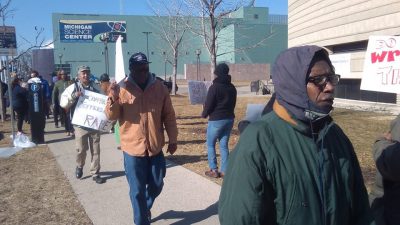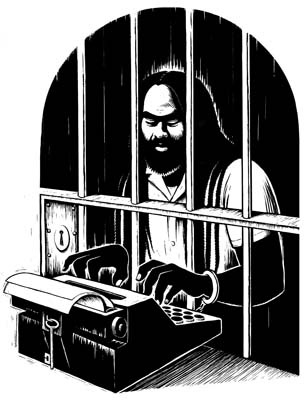From One Struggle to Another, Abolition Now! Mumia Abu Jamal

When one thinks of the term abolition, there is a tendency to see it as a threat emerging from the left. Another perspective understands, however, that abolition is a natural response to a situation that has become untenable.
What condition lay before the nation in its founding days? Slavery: human bondage, which sat like an incubus upon the new nation’s foundation, and transformed its stated aims and ideals into lies. After some reflection, perhaps, we will see that the notion of abolition has deep historical roots. Consider summer, 1776, when delegates from the Continental Congress gathered in a sweltering room in Philadelphia. These men, some of the country’s intellectual elite, were scientists, writers, doctors, and thinkers, yet their claims of the new nation’s ideals were thick with contradiction. They wrote and adopted a document that said, among other things, the following:
We hold these Truths to be self-evident, that all Men are created equal, that they are endowed by their Creator with certain unalienable Rights, that among these are Life, Liberty and the Pursuit of Happiness. That to secure these Rights, Governments are instituted among Men, deriving their just Powers from the Consent of the Governed, that whenever any Form of Government becomes destructive of these Ends, it is the Right of the People to alter or abolish it.
These words emerge from the Declaration of Independence, adopted July 4, 1776, and celebrated throughout the U.S. annually on Independence Day today.
 When people came together in the 19th century to oppose the expanding slave system, they were called abolitionists. Among both the rulers and the press, such people were regarded as oddballs at best, and nuts at worst. Despite present popular opinion, slavery was the air that people breathed. The nation was so deeply and openly negrophobic and racist, that the idea of a multiracial group opposed to slavery was considered aberrant.
When people came together in the 19th century to oppose the expanding slave system, they were called abolitionists. Among both the rulers and the press, such people were regarded as oddballs at best, and nuts at worst. Despite present popular opinion, slavery was the air that people breathed. The nation was so deeply and openly negrophobic and racist, that the idea of a multiracial group opposed to slavery was considered aberrant.
Furthermore, the document, signed by such luminaries as Ben Franklin, Thomas Jefferson, Dr. Benjamin Rush, and John Adams, included platitudes like “all men are created equal,” while dark men, property-less white men, and all women were neither able to vote nor be voted for posts of political power. Indigenous people were seen as part of a distant wilderness and not part of the nation that was being contemplated.
In October 1859, white abolitionist leader John Brown, joined by 21 men, raided the U.S. Armory at Harpers Ferry, Virginia, in an attempt to arm African captives in neighboring plantations so they could strike out for freedom. Such an attempt had to face fierce logistical challenges, given the communications needed to gain the ear and trust of a largely illiterate and deeply repressed enslaved community, constantly subjected to white armed militia surveillance.
Abolitionists brought forth another vision, and hence, another future. Harpers Ferry, Virginia, was a step in the fateful march to war that, after earth-shaking sacrifice, led to the abolition of slavery.
Abraham Lincoln, one of the most admired presidents in history, would describe the raid and the raiders as little better than lunatics and regicides, less than a year after the attack failed. In February, 1860, Lincoln spoke before a crowd at New York’s Cooper Institute (now known as Cooper Union) to distance himself and his party (Republicans) from the Harpers Ferry raid. Lincoln told his audience that Brown wasn’t a Republican, and that Republicans had nothing to do with the raid. Indeed, Lincoln assured his northern audience that neither he nor his party supported abolition. And, truth be told, this is far from a remarkable perspective, for the fact of chattel slavery was one deeply normalized in American experience and history.
Indeed, abolition was the exception, not the rule.
What this means, of course, is that abolitionists were truly remarkable people who saw beyond the present into a time not yet born. Spurred often by religious convictions, abolitionists supported attacks against the slave system, which they saw as an unnecessary evil.
In 1858, a year before the Harpers Ferry raid, Lincoln opined that slavery would last for at least 100 more years — or at least until 1958 or the 1960s. It is important to note that Lincoln’s prognostication was meant to appease the slavocracy. It was not an assessment of the counterrevolutionary dynamic that would detonate after the war.
Despite this observation, what that means to us writing from the 21st century is that people we now regard as successful African American leaders and entrepreneurs like Oprah Winfrey, Rev. Dr. Martin Luther King, Jr., Thurgood Marshall, Rev. Jesse Jackson, Duke Ellington, Lena Horne, Muhammad Ali, Dr. Maya Angelou, Debbie Allen, Toni Morrison, Malcolm X, Bessie Smith, Maxine Waters, Alex Haley, Lerone Bennett, Hank Aaron, and, yes, even Supreme Court Justice Clarence Thomas, would have been born into captivity, if Lincoln’s opinion prevailed.
Abolitionists brought forth another vision, and hence, another future. Harpers Ferry, Virginia, was a step in the fateful march to war that, after earth-shaking sacrifice, led to the abolition of slavery. Thus, abolition was not a skip in the park. It is a deep, committed movement of social transformation that seeks to bring down institutions that needlessly inflict pain upon the People.
Abolitionists like Frederick Douglass, Harriet Tubman, and John Brown forged a new America, one unimaginable to earlier generations. They saw farther than their contemporaries, and even warned them of problems threatening from the periphery.
In May 1865, a month after the Confederacy surrendered to Union forces, Douglass delivered a potent warning for his fellow abolitionists about the counterrevolutionary threats that emerged from the ruins of the Civil War:
Slavery has been fruitful in giving itself names. It has been called ‘the peculiar institution,’ ‘the social system,’ and the ‘impediment’… It has been called by a great many names, and it will call itself by yet another name; and you and I and all of us had better wait and see what new form this old monster will assume, in what new skin this old snake will come forth next.
Douglass’s warning, about the mutability of that old racist snake, was not heeded. The achievements of Reconstruction were drowned in a sea of terror and blood.
The lessons of the noble anti-slavery Abolition Movement is before us. It is a lesson to struggle and struggle, from generation to generation, until the People are finally free, and that ‘old snake’ has no more masks behind which to hide.
Abolitionists tried to make the nation live up to its promises of equal justice, of freedom, and the rights enshrined in the Reconstruction Amendments set forth in the 13th, 14th, and 15th Amendments to the Constitution, which were designed to protect the rights of Black citizens.
The Reconstruction Era marked the brief period of Black postwar freedom until the U.S. Supreme Court overturned the 1875 Civil Rights Act. In that era, white supremacists waged a terror war against Black people, and maintained it for the better part of a century, until the emergence and rise of the Civil Rights Movement of the 1950s and 1960s. The lessons of the noble anti-slavery Abolition Movement are before us. The lessons to struggle and struggle, from generation to generation, until the People are finally free, and that “old snake” has no more masks behind which to hide.
The 13th amendment ensured the continuation of slavery by another name — in the guise of the carceral state. Today, prisons are the third largest employer in the nation according to sociologist Loïc Wacquant — and Black people are, once again, its currency.
Although we have drawn from the text of the Declaration of Independence to cite “the Right of the People… to abolish” unjust systems that threaten the Life, Liberty, and Pursuit of Happiness of the People, that right doesn’t arise from the document. It comes from the hearts, minds, and urgings of the People — the living People who today breathe the air that sustains us all. Is that not the same energy that calls us to support today’s abolition movement, that works to tear down the system that deprives millions of people — entombed in prison cells and solitary confinement and in this prison house of nations — of their Life, Liberty, and the Pursuit of Happiness?
We need not historicize questions, nor cast them into the hoary days of the past. They live within us, in our hopes, our dreams, our visions of a world free of such repressive systems that are but the shadows of slavery. Abolition Now!
*
Note to readers: please click the share buttons above or below. Forward this article to your email lists. Crosspost on your blog site, internet forums. etc.

